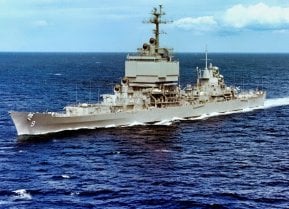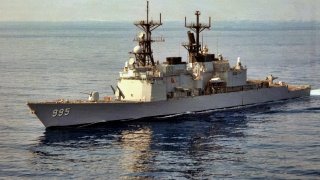Kidd-Class Destroyers: From Iran's Order to Taiwan's Frontline Defense
Originally built for the Imperial Iranian Navy, the Kidd-class destroyers found a new home with the navy of Taiwan following the 1979 Islamic Revolution in Iran.
Summary: Originally built for the Imperial Iranian Navy, the Kidd-class destroyers found a new home with the navy of Taiwan following the 1979 Islamic Revolution in Iran. These advanced guided-missile destroyers, initially requested by Shah Mohammad Reza Pahlavi and designed with modifications for Middle Eastern conditions, were never delivered to Iran due to the changed political landscape. Instead, they were integrated into the U.S. Navy before being sold to Taiwan in 2001, where they were renamed Kee Lung-class destroyers. Equipped with enhanced air conditioning, dust separators, and now boasting sophisticated armaments and electronic warfare suites, these ships play a crucial role in Taiwan's defense, particularly amid rising tensions in the South China Sea. The Kidd-class's journey from Iran to Taiwan underscores the complex interplay of international relations and military strategy, highlighting their enduring value as multi-mission ships capable of addressing a variety of threats.
The Remarkable Journey of the Kidd-Class Destroyers
The American-made Kidd-class destroyers were built for the former Imperial Iranian Navy. The ships ended up serving instead in the navy of Taiwan.
These guided-missile destroyers (DDGs) were built as multi-purpose boats equipped with sophisticated anti-aircraft capabilities. Prior to the 1979 Islamic Revolution in Iran, the U.S. provided certain military systems to Tehran. After the fall of the Shah, however, the relationship between Tehran and Washington would change, and the Kidd-class contracts were canceled. By the end of the 1990s, the DDGs were decommissioned and sold to Taiwan, where they have remained in service ever since.
Kidd-Class History
The former Shah of Iran, Mohammad Reza Pahlavi, requested the Kidd-class destroyers from the U.S. in the early 1970s. Iran’s initial order was for six ships, tentatively assigned hull numbers DD-993 to DD-998. Such a robust order, however, would have interfered with U.S. production of its own Spruance-class ships, so Washington agreed to deliver only four of these DDGs.
Since these DDGs were originally intended for Iran’s navy, engineers incorporated features that made them better suited to operate in the Middle East. From additional air conditioning plants to dust separators, the Kidd ships were uniquely designed to Iran’s needs.
When the contract was later canceled, the U.S. Navy decided to integrate the vessels into its own fleet in the early 1980s.
The lead ship of the class, the USS Kidd, was named to honor Rear Adm. Isaac C. Kidd, who died aboard the USS Arizona during the attack on Pearl Harbor. The remaining ships in the class followed suit, each being named for an admiral who died in World War II.
Taiwan’s Purchase of the DDGs
The four Kidd-class destroyers were sold to Taiwan in 2001. Renamed as Kee Lung-class destroyers, these boats have received significant upgrades. Today, the Kee Lung-class ships are equipped with naval tactical data systems and sophisticated armaments. They carry two Mk26 launchers and two Mk141 quadruple canisters capable of firing Harpoon anti-ship missiles and RIM-66 standard missiles. The two primary guns fitted on the DDGs are 127mm/54 caliber, Mark 45 dual-purpose guns. Two Phalanx Close-In Weapons Systems are also carried.
In terms of countermeasures, the destroyers possess AN/SLQ-32V3 Outboard II Electronic Warfare suites. As detailed by Naval Technology, this system is efficient at detecting, processing, and analyzing enemy electronic emissions.
As tensions continue to mount in the South China Sea, the maintenance of the Kee Lung-class destroyers remains essential. Among the few truly multi-mission ships able to operate offensively and contend with simultaneous air, surface, and subsurface attacks, these DDGs play an important role in Taiwan’s fleet.
About the Author: Maya Carlin
Maya Carlin, National Security Writer with The National Interest, is an analyst with the Center for Security Policy and a former Anna Sobol Levy Fellow at IDC Herzliya in Israel. She has by-lines in many publications, including The National Interest, Jerusalem Post, and Times of Israel. You can follow her on Twitter: @MayaCarlin. Email the author: [email protected].
Image Credit: U.S. Navy/Creative Commons.


